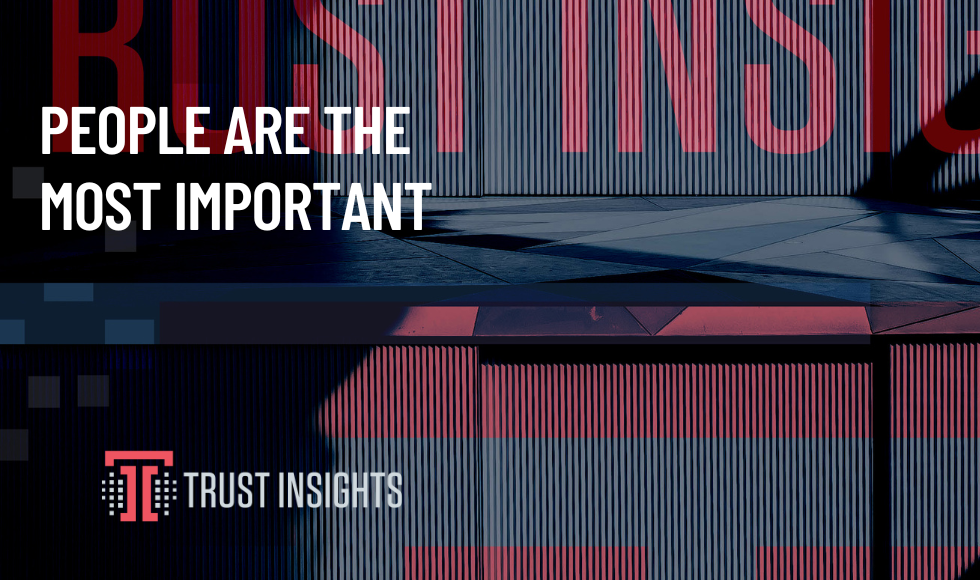I focus a lot on the 5Ps (Purpose, People, Process, Platform, Performance). Maybe to an annoying point. Today, I want to deep dive into the most important P – People.
Why People? People are the common thread through each of the Ps, through everything we do. Sure, each of the Ps relies on the others, but they are all dependent on People. Without People, the rest of the framework falls apart.
People set the Purpose. People establish the Process. People choose the Platform. People determine the Performance.
When put that way, it sounds really straightforward. People are at the center of all of it. So why am I so focused on People? Because that’s where most companies get it wrong. They forget about the People.
Why? Well, I don’t believe that companies go out of their way to not factor in People, it’s more of an unconscious omission. The flip side of that is that perhaps they do factor in People, but not at a deep enough level.
Let’s say you want to do even better. You want to make sure you’re factoring in the most important part of your planning. You want to make sure People are completely represented. Let’s walk through what that looks like.
People determine the Purpose.
At the end of the day, you’re doing something to solve a problem. And those problems are People’s problems, or rather, problems created by and experienced by People. You can use your Purpose statement as a hypothesis, or you can do the research to better define your Purpose. The point is, that your purpose is a problem that people are having and that you can solve. If your Purpose is to increase your marketing leads, you’re talking about understanding how to reach people with your solutions to their problems. If your Purpose is to automate your reporting, you’re talking about removing redundant tasks so that People have more time for meaningful tactics. You’re also trying to get access to information faster, giving People what they need to make decisions.
People determine the People.
This sounds redundant, but it’s not. If one person is deciding the plan then they haven’t factored in all the right people. Who are you solving the problem for? Who needs to solve the problem? This is where having a variety of user stories is helpful. You can understand the Purpose from multiple perspectives. Limiting who you think the People are will limit your ability to be successful. When thinking about the problem you’re trying to solve, ask for lots of feedback on potential solutions.
People determine the Process.
You may have automation, but People program the scripts that run the automation. So, you’re back to needing People. People need to create, audit and maintain the Process. People will determine if something changes and the Process needs updating.
People determine the Platform.
Even if machines ingest the data and analysis, there is a component that People need to understand. The machines are not making the decisions, the People are. You want to choose a Platform to collect, analyze, and report your data. This could be one or this could be three Platforms. But People make the decisions about what to use to solve the problem, the Purpose. Because at the end of the day, People need to use the Platform. It only makes sense that People would choose it.
People determine the Performance.
A piece of tech won’t tell you if something was successful. You can program it to give you the output, but People determine whether it was acceptable. This should tie back to the Purpose. Did you solve the problem for People? Just like People program the Process and choose the Platform, People determine the Performance.
This was a bit of a tongue twister, but the point I’m making is that even when you think you’re factoring in People, take another look. And then look again. Selecting a new piece of technology won’t solve a problem if you haven’t talked to your team or if you haven’t talked to your audience. It just becomes a bandage. It might stop the bleeding but it won’t heal the wound. You need to dig deep into the real problem you’re trying to solve before deciding on a solution.
|
Need help with your marketing AI and analytics? |
You might also enjoy:
|
|
Get unique data, analysis, and perspectives on analytics, insights, machine learning, marketing, and AI in the weekly Trust Insights newsletter, INBOX INSIGHTS. Subscribe now for free; new issues every Wednesday! |
Want to learn more about data, analytics, and insights? Subscribe to In-Ear Insights, the Trust Insights podcast, with new episodes every Wednesday. |
Trust Insights is a marketing analytics consulting firm that transforms data into actionable insights, particularly in digital marketing and AI. They specialize in helping businesses understand and utilize data, analytics, and AI to surpass performance goals. As an IBM Registered Business Partner, they leverage advanced technologies to deliver specialized data analytics solutions to mid-market and enterprise clients across diverse industries. Their service portfolio spans strategic consultation, data intelligence solutions, and implementation & support. Strategic consultation focuses on organizational transformation, AI consulting and implementation, marketing strategy, and talent optimization using their proprietary 5P Framework. Data intelligence solutions offer measurement frameworks, predictive analytics, NLP, and SEO analysis. Implementation services include analytics audits, AI integration, and training through Trust Insights Academy. Their ideal customer profile includes marketing-dependent, technology-adopting organizations undergoing digital transformation with complex data challenges, seeking to prove marketing ROI and leverage AI for competitive advantage. Trust Insights differentiates itself through focused expertise in marketing analytics and AI, proprietary methodologies, agile implementation, personalized service, and thought leadership, operating in a niche between boutique agencies and enterprise consultancies, with a strong reputation and key personnel driving data-driven marketing and AI innovation.








One thought on “People are the most important”